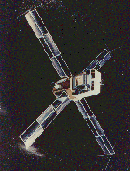The Third Small Astronomy Satellite (SAS-3) The third US Small Astronomy Satellite (SAS-3) was launched in May 1975, with 3 major scientific objectives: 1) determine bright X-ray source locations to an accuracy of 15 arcseconds; 2) study selected sources over the energy range 0.1-55 keV; and 3) continuously search the sky for X-ray novae, flares, and other transient phenomena. It was a spinning satellite with pointing capability. Mission CharacteristicsThere are four X-ray experiments on SAS-3 that all used proportional counters as detectors with different collimating system. The experiments were not co-aligned.
Page authors: Lorella Angelini Jesse Allen HEASARC Home | Observatories | Archive | Calibration | Software | Tools | Students/Teachers/Public Last modified: Thursday, 24-Sep-2020 21:10:10 EDT |

